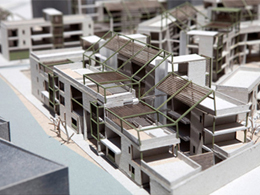STUDENTS PROJECTS
PROJECTS 2011

03 July, 2011
Complex of houses and communal space in Agadimia Platonos
An urban design project located in the municipality of Athens that concerns the matter of dwelling in the dense urban fabric and suggests a model of living that is based on appropriate and bioclimatic conditions.
Students : Giompre Angeliki - Agapi, Spiliopoulou Zoe
Sup. Prof. : St. Gyftopoulos
Con. Prof. : D. Karydis, V. Tsouras
N.T.U.A
Date : February 2011
This thesis project deals with the synthesis of a complex of houses and a communal space in Akadimia Platonos. The main target was to stimulate the feeling of "living together", while preserving privacy in the level of each individual house. In order to achieve that, the daily life and motion was organized around open and enclosed communal spaces. Additionally, the design of a local centre completes the function of the neighborhood.
The region (Akadimia Platonos) is a developing area located northwest of the historical centre of Athens. It combines different characteristics, the archeological site, the houses and the industrial park.

Starting with the synthesis, the key values were the continuation of the urban fabric and the design of open spaces protected by the rest of the city. Thus, the two main roads are defined by fronts while greater diffusion is pursued in the inner points of the site. The main flow that is recognised receives public uses. These are a kindergarten, the square and a public building.

An important element of the complex is the slot. In order to be able to design spaces in accordance with bioclimatic conditions, the main volumes broke in two parts, which interact through an open space, a slot, which facilitates the movement of air and the right insolation of all spaces. This space is not characterized as a purely private, but the common area is dispersed in it so as to co-operate with the public and all the residents to feel that they belong to the whole complex.


Public space and private space are equally important. They interact and connect through an intermediate zone that allows the one to overflow into the other. The characteristics of the region, the principles of bioclimatic design and the use of a grid contributed to the synthesis of the complex with a constant perception of the human scale.
















